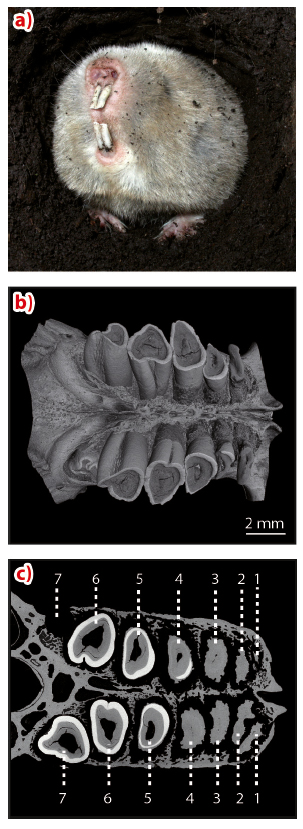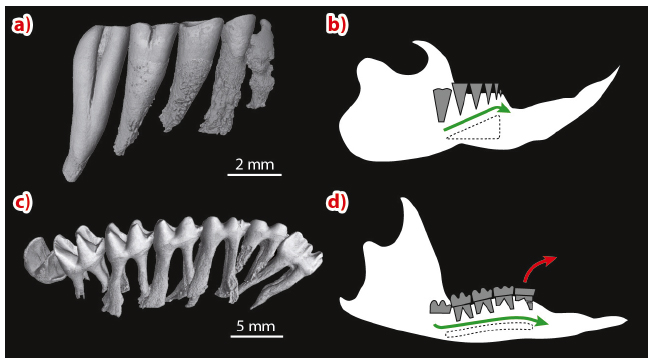- Home
- Users & Science
- Scientific Documentation
- ESRF Highlights
- ESRF Highlights 2011
- X-ray imaging
- Investigating the continuous dental replacement of mammals through a new rodent model
Investigating the continuous dental replacement of mammals through a new rodent model
Continuous dental replacement is an exceptional mechanism in mammals because they usually have only two generations of teeth, contrary to their reptilian ancestors. In continuous dental replacement there is constant addition of teeth at the rear of the jaw. Up to now, this characteristic has been only found in the pygmy rock-wallaby and in manatees, and it remains barely documented. However, we recently discovered an African mole-rat displaying unusual dentition, which reopens the debate concerning tooth replacement and the origin of supernumerary teeth in mammals.
The silvery mole-rat (Heliophobius argenteocinereus) is a solitary African rodent that spends most of its lifetime digging burrows in order to find food (Figure 130a). Occurrence of only a few supernumerary teeth has already been mentioned for this rodent, but continuous dental replacement had never been proposed, nor investigated. By means of the X-ray synchrotron microtomography, using beamlines ID19 and BM05 (at 25 keV, cubic voxel of 5.06 µm), the dental characteristics of this African mole-rat were accurately imaged to highlight the various properties of its dental replacement mechanism. Among 55 investigated skulls of H. argenteocinereus, one juvenile and one adult were chosen to be scanned. Comparisons have also been drawn with the dentitions of manatees and the pygmy rock-wallaby. The dental characteristics of the wallaby have also been investigated using beamline ID19 (at 60 keV, cubic voxel of 7.46 µm).
While the molar number never exceeds three in placental mammals, the silvery mole-rat can bear up to seven molars (Figure 130b-c). Indeed, the molars of this rodent are continuously replaced, since new teeth regularly erupt at the rear of the jaw, pushing the anterior teeth, which become extremely worn, and finally resorbed inside the bone (Figure 130c). The very high quality and precision of synchrotron reconstructions permitted us to visualise the resorption of both root and crown (Figure 131a), which is led by the compressive action of erupting molars on anterior molars. The originality of this dentition also relies on its high-crowned teeth. As a result, the occurrence of continuous dental replacement coupled to high-crowned teeth constitutes an excellent “escalator-like” dental mechanism (Figure 131b), necessary to withstand the effects of severe wear on teeth. This solitary rodent actively digs with its incisors irrespective of the hardness of the soil, therefore, we hypothesised that high wear of the molars could be linked to severe dental friction occurring during both digging and feeding.
 |
|
Fig. 130: a) Foreside of a captive silvery mole-rat, b) 3D reconstruction and c) Virtual cross-section of the upper dentition of an adult silvery mole-rat. |
What do the comparisons with other mammals having continuous dental replacement reveal? Manatees and the small wallaby display low-crowned teeth contrary to this mole-rat. Moreover, their dental resorption is only efficient for the roots of their teeth. Synchrotron reconstruction of the wallaby’s dentition also allowed us to clearly show that the anterior molars are not totally resorbed (Figure 131c), but rather they are shed when they reach the front of the jaw. Even if the mechanism is convergent with the rodent’s dental system, it still reminds one of a “treadmill” (Figure 131d), and is clearly optimised for gnawing abrasive plants. Apart from these differences, we found that the three mammals and some of their extinct and extant relatives shared some biological traits essential for continuous dental replacement. They comprise a forward movement of new teeth from the rear to the front of the jaw (mesial drift), the continued eruption of teeth after the age of sexual maturity (delayed eruption), and the growth of extra teeth (supernumerary teeth).
What is the main biological interest of this rodent? Manatees and the pygmy rock wallaby are not suitable for an accurate study of continuous dental replacement, because of their size and their endangered status.
Mice, the usual biological model, do not have any of the dental characteristics previously detailed. Consequently, this mole-rat could be the better biological model for an extensive study of the continuous dental replacement’s underlying mechanism, which could represent a basis to understand the developmental and molecular processes leading to additional molars. Further research on this topic will be of high interest, notably regarding the knowledge of dental stem cells in relation to the origin of extra teeth in mammals, and thus leading to the eventual goal of the regeneration of dental tissue in humans.
Principal publication and authors
H. Gomes Rodrigues (a), P. Marangoni (a), R. Šumbera (b), P. Tafforeau (c), W. Wendelen (d) and L. Viriot (a), Proc. Natl. Acad. Sci. 108, 17355-17359 (2011).
(a) IGFL-ENS Lyon-UCBL1 (France)
(b) PrF, University of South Bohemia, Ceské Budejovice (Czech Republic)
(c) ESRF
(d) Royal Museum for Central Africa, Tervuren (Belgium)




